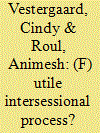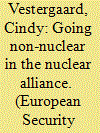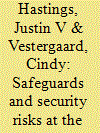|
|
|
Sort Order |
|
|
|
Items / Page
|
|
|
|
|
|
|
| Srl | Item |
| 1 |
ID:
107568


|
|
|
|
|
| Publication |
2011.
|
| Summary/Abstract |
During its thirty-five years, the Biological Weapons Convention (BWC) has been scarred by treaty violations, failed compliance negotiations, and ambiguous treaty language. Essentially a bruised paper tiger, the BWC adds no clarification to its distinction between biological activities for peaceful versus hostile purposes and has amplified-rather than lessened-mistrust in states' biological research and development potential. For the past two decades, these circumstances have generated multilateral annual discussions on BWC issues. From 2003 to 2010, intersessional talks centered on less controversial topics in an attempt to save the treaty from spiraling political tensions. States generally agree that this intersessional process was not futile and that it cooled some of the negative effects of the failed negotiations over a compliance protocol. At the upcoming Seventh BWC Review Conference this December, treaty members will weigh the utility of extending the process and its accompanying administrative Implementation Support Unit. The challenge will be to stimulate the evolution of the BWC beyond its hollow characterization to strengthen and inspire confidence in the treaty regime. This article examines the BWC's ambiguous language and how it has affected diplomacy, reflects on intersessional discussions, acknowledges the (limited) scope of appropriate peaceful activities that can be identified under the BWC, and addresses ways in which to reinvigorate the treaty.
|
|
|
|
|
|
|
|
|
|
|
|
|
|
|
|
| 2 |
ID:
127855


|
|
|
|
|
| Publication |
2014.
|
| Summary/Abstract |
Non nuclear Danish nuclear policy is at a crossroads. Looking back, Denmark's relationship to nuclear technology has been a difficult balancing act for successive governments, trying to soothe an anti-nuclear domestic sentiment on one side and the membership of a nuclear military alliance on the other. This history produced an enduring double approach to nuclear policy by Copenhagen throughout the cold war. Looking ahead, this history is of particular relevance as Denmark and Greenland are considering lifting their twenty-five-year ban on mining radioactive elements and allowing the production of Greenland's uranium. With Greenland's large reserves potentially catapulting this otherwise non-nuclear and non-mining kingdom into one of the world's top suppliers of uranium, the policy debate has to include a look back at Denmark's relationship to nuclear technology, for both peaceful and military purposes.
|
|
|
|
|
|
|
|
|
|
|
|
|
|
|
|
| 3 |
ID:
167795


|
|
|
|
|
| Summary/Abstract |
Historically, there have been limited international controls at the very front end of the nuclear fuel cycle, which consists of mining, processing, transportation, and conversion of natural uranium. However, an evolving framework of nuclear-security treaties along with International Atomic Energy Agency clarifications of the materials subject to its safeguards obligations are increasing the coverage of source materials, raising the question of how new and traditional uranium suppliers should handle safeguards and security in the production of uranium. We use a risk framework to assess the likelihood and consequences of different proliferation risks. Although the consequences for proliferation are generally low, risks to the very front end are different for safeguards (state diversion) and nuclear-materials security (unauthorized removal by non-state actors). For safeguards risks, cases of diversion or undeclared activities are concentrated at conversion facilities, while theft or trafficking of front-end material represents a relatively small percentage of total security incidents, concentrated in countries with lower levels of nuclear-materials security. We conclude that safeguards and security obligations should be commensurate with the risks. An appropriate response should involve a risk-based, graduated approach to nuclear security and a flexible, more clearly framed approach to safeguards.
|
|
|
|
|
|
|
|
|
|
|
|
|
|
|
|
|
|
|
|
|